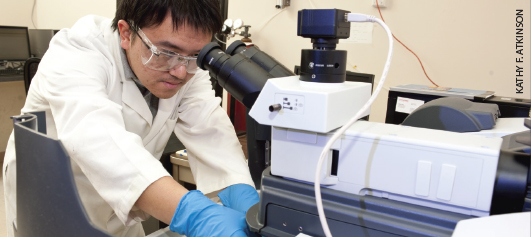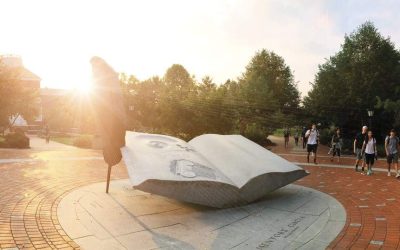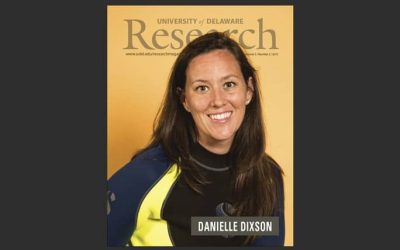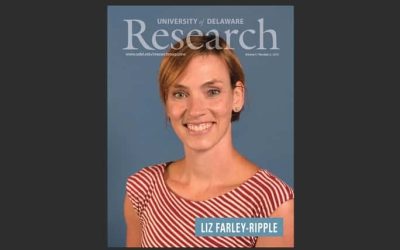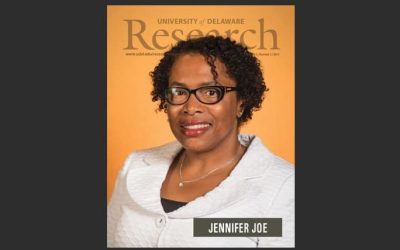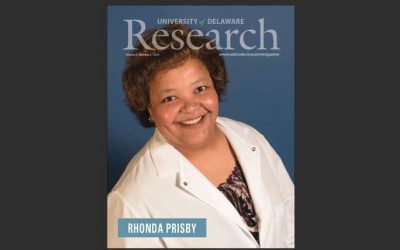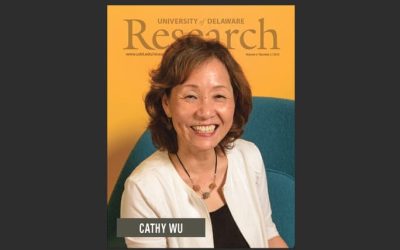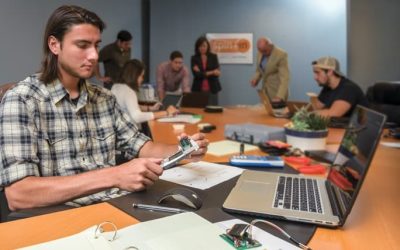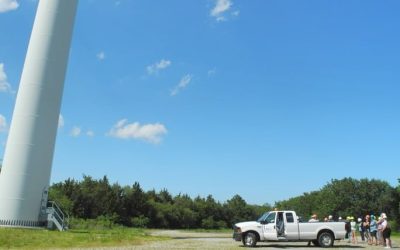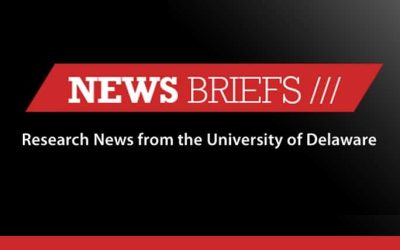
If we could capture it all for just 90 minutes, that beautiful shining star in the sky—our sun—would deliver enough power to satisfy this planet’s appetite for electricity for about a full year, scientists say.
In six days, the sun could deliver nearly a century of power—if demand remained constant. And if demand surges, as expected—well, give it another day or two.
If only.
Courtesy of NASA’s Solar Dynamics Observatory.

The University has been a center of pioneering solar research since before it was fashionable—before the oil embargo of 1973, before long lines formed to get rations of gasoline, before the nation had a Department of Energy or the word “green” became a badge of good stewardship.
And this is a great time to be in the middle of that work. Solar-generated energy, now representing a small fraction of the nation’s electricity supply, is a burgeoning industry, representing almost a third of the new capacity installed in 2014.
A time-lapse map on the Department of Energy’s website shows the surge from the utility perspective across the United States, starting in 1983 with zero solar plants online.
Ten years later, 10 plants were online with enough juice to power about 100,000 homes. By 2003, there were only 15 plants and enough power for about 103,000 homes. By 2013, though, there were 682 plants able to deliver power to 1.7 million homes. And when you include the hundreds of thousands of residential and commercial rooftops covered with solar panels, their installation is growing at over 50 percent per year, doubling every few years.

The speed of that growth turns on resources and advances in technology, the kind that have been underway at the University of Delaware’s Institute of Energy Conversion (IEC) since 1972.
Karl Böer, Distinguished Professor Emeritus of Physics and Solar Energy, was at the forefront then, working on thin-film photovoltaics as the founder of the IEC, which has produced more than 45 patents in its 43 years.
Böer had come to Delaware in 1962 from Humboldt University of Berlin, Germany, which counted among its luminaries and lecturers such names as Karl Marx, Albert Einstein, Dietrich Bonhoeffer and a total of 40 Nobel laureates.
Böer’s work in physics took a sharp turn toward solar energy as he saw what was happening on the planet.
“If you are awake in the morning and know what’s going on, you know we can no longer burn coal and oil and so on,” said Böer, who now lives in Naples, Fla.
His early work in thin-film photovoltaics focused on solar cells made of layers of cadmium sulfide (CdS) and copper sulfide (Cu2S). Now, IEC focuses on other thin-film materials—cadmium telluride (CdTe), copper indium gallium selenide (CIGS) and amorphous silicon (a-Si).
Thin-film photovoltaics are extremely thin, using layers that start at a few nanometers (that’s a few billionths of a meter, not much wider than a strand of DNA). Compared to the more conventional silicon cells, thin-film materials are much lighter in weight and can be used in flexible applications. But those same properties mean they must be applied to and supported by another surface, which can add to their weight and affect other properties.
“You have to understand the fundamental properties of the material and the layers,” said physicist William Shafarman, senior scientist at IEC and an associate professor of materials science.
If you put thin-film materials between two sheets of glass, for example, you have to know how those materials will interact, how to control the properties of each and how to make such panels in reliable, industry-friendly ways.
IEC established several milestones in thin-film technology. It was the first laboratory to get 10 percent efficiency out of the materials, and it pioneered the “roll-to-roll” manufacturing process, exploiting the flexibility of thin films to develop a continuous rollout and cut production costs.
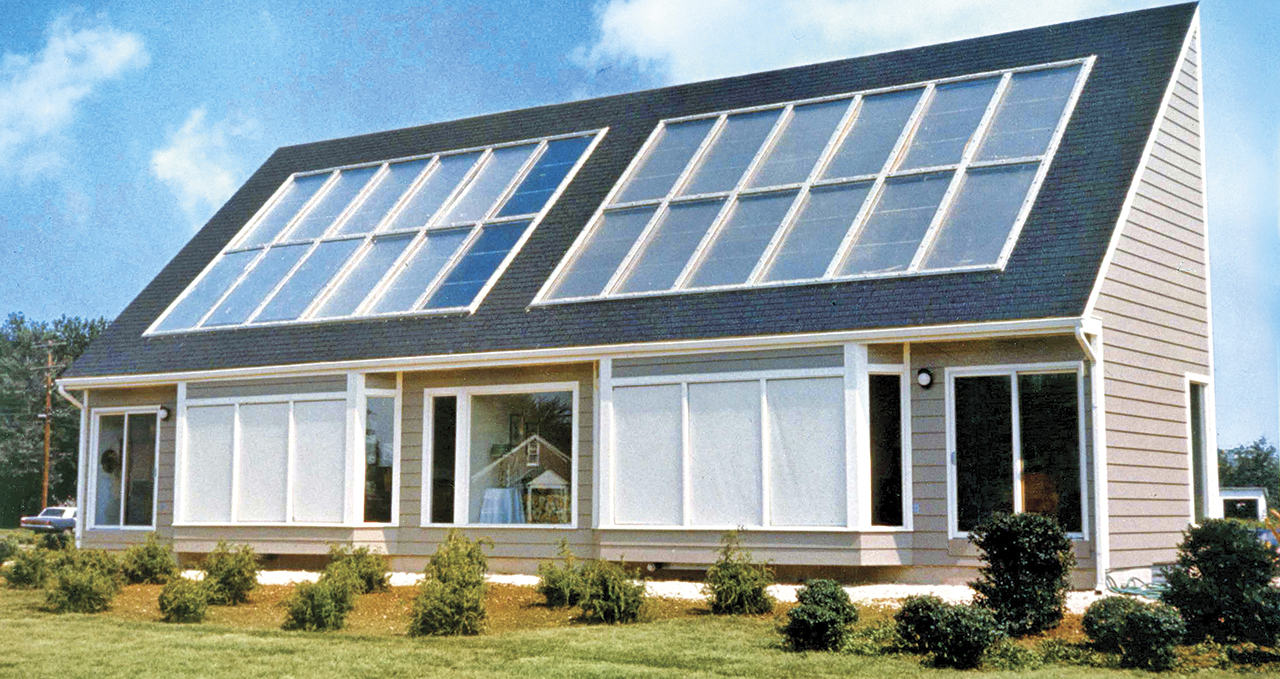
With support from Delmarva Power and Light, IEC built Solar One, a thin-film solar cell demonstration project, in 1973. It was the first experimental house to convert sunlight into both heat and electricity for domestic use and drew thousands of visitors.
The house showed the practical potential of thin-film and passive solar technologies, producing both electricity and heat and—in the process—drawing thousands of visitors to Newark after its completion in 1973. The novelty made headlines with NBC News and Long Island, N.Y.’s Newsday, to name a few outlets, and Popular Science called it “the most technologically advanced solar house now in existence.”
Its glory days are past and the solar panels are gone, but the Solar One house still stands as an unassuming testament to the trailblazing work by UD researchers and their students.
At the IEC, an extensive and varied collection of solar panel samples is on display—probably the most substantial such collection in the world, according to Shafarman. The panels, each marked with the date of development and other information, are lined up for students and others to examine and compare.
The display and extensive research demonstrate that solar energy progress takes time. Some ideas produce a lot of hype, which “most of the time doesn’t pan out,” said Steven Hegedus, senior scientist at IEC and associate professor of electrical and computer engineering who has worked in solar research for more than 30 years.
“Remember, it takes 10 years or more for a technology to go from the laboratory to full-scale production,” he said. “There’s a lot of testing, validation, optimization. Making something once in the lab is hard. Making it day in, day out, thousands of modules a day, is really hard.”
But incremental progress has been a constant, he said.
Thin-film efficiency has doubled—to more than 20 percent, Shafarman said. But it still lags behind the standard silicon wafers, which are closer to 25 percent.
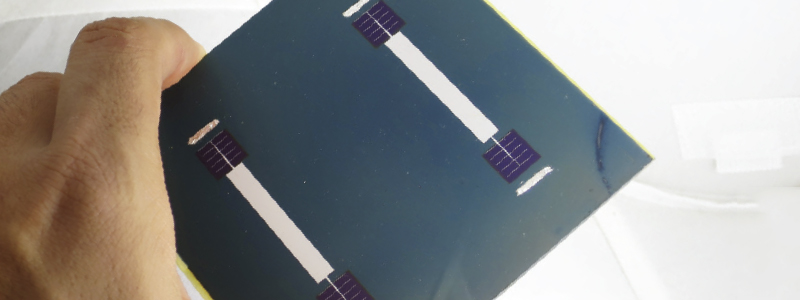
Thin-film solar cells, the focus of research at IEC, are much lighter than other materials and can be fabricated on glass or flexible foils. Above shows thin-film solar cells on glass fabricated at IEC. IEC has established several milestones
in thin-film technology.
Efficiency is an important problem for researchers and industry. When a system is said to be 25 percent efficient, it means it is converting a quarter of the power it absorbs. Seventy-five percent, in other words, goes unused.
Industry leaders often turn to IEC for help with performance issues or plans for a new product, and IEC has a strong team of scientists, graduate-level students and postdoctoral fellows with the training and experience to assist them. Shafarman said he and others often take calls from businesses looking for potential employees with strong solar credentials.
The IEC, directed since 1996 by physicist Robert Birkmire, professor of materials science and engineering, also participates in many Department of Energy initiatives and collaborates with other universities and national labs.
“There is still a need for new ideas,” Shafarman said, “and new ways to make solar cells with low-cost materials.”
Böer urges students to continue that quest and pursue a comprehensive understanding of the science and the systems.
“Look at the materials, the systems, understand the physics behind it,” he said. “Study solid state physics and solar energy. Study electrical energy and electrical engineering. Study solar engineering.”
And help the world catch more rays.
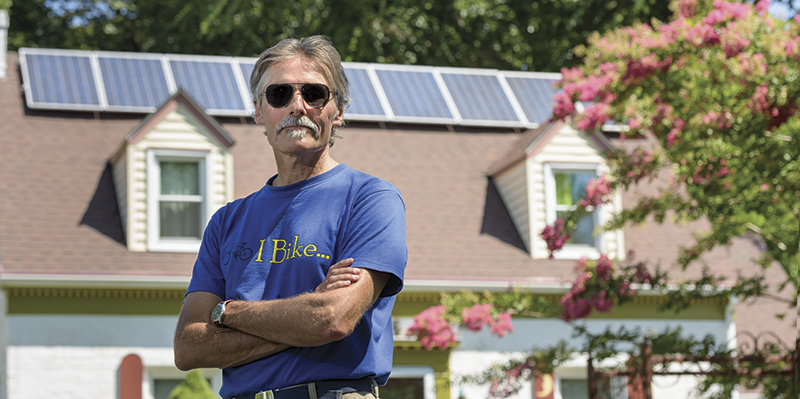
His place in the sun
Steven Hegedus remembers the moment they flipped the solar switch at his Newark house on a February afternoon in 2007.
He and his wife were the first homeowners in town to install solar panels on their roof and Hegedus—senior scientist and a solar expert at the University of Delaware’s Institute of Energy Conversion—was keen to see what would happen.
They had turned off major systems in the house in case of an installation glitch. But there was no glitch, and shortly after the solar system went live, it was clear the tide had turned.
The rotating disk that was part of the electric meter now was slowing, slowing, slowing. Then it stopped and started turning in the opposite direction—in Hegedus’ favor— sending the surplus electricity from the solar array back to the grid.
“My wife and I were in the driveway going ‘woo-hoo!’” he said.
Since that day eight years ago, Hegedus’ power bills have dropped by about two-thirds. And his belief in the promise of solar power is stronger than ever, which is saying something.
With more than 30 years of research in photovoltaics, Hegedus is an expert in solar electricity and solar cell manufacturing and an associate professor of electrical and computer engineering. He was co-editor with Antonio Luque of Spain of the Handbook of Photovoltaic Science and Engineering, a standard in the field and an often-cited text.
“I wanted to be part of this movement that I’ve been doing research on,” he said. “It makes me a better proponent and advocate. I can use the data from my system, analyze it and show students in my class that our modeling actually works. When I go to talk to schools or churches that are thinking about going solar—I’ve done this. I took the leap.”
For the first few years after the system was installed, Hegedus says people would stop at the house, wanting to know more. He was glad to oblige.
Nine modules are on the roof of his house, each with 200-watt capacity. An inverter in the basement changes direct current to alternating current. Production varies with temperature, sunlight and time of day, Hegedus said.
It may be surprising to learn that the system’s peak production typically occurs on the coldest day of the year—a cloudless, bright winter sky with no humidity to scatter the sunlight. Plus, the solar panels are most efficient when it’s cold, Hegedus said.
Monthly averages, though, show July at the top, with longer days and the sun higher in the sky.
The only time the panels produce zero energy is when they are covered with snow, he said. And it typically slides off the next day due to the steep slope of his roof.
The panels have a life expectancy of about 25 years, he said, when they would still be producing a not-too-shabby 80 percent of their rated power.
“What other electronic device do we expect to be outside and functioning every day in the weather for 25 years? Streetlights maybe.”
Hegedus was on the roof with the installer to see that process in action and continues to monitor the system’s performance using the Delaware Environmental Observing System to track solar radiation data in his area.
He hopes IEC will increase its work on solar system performance analysis and reliability testing.
“These are important issues for the growth of the business and also important for students to learn as they go into the working world,” he said.
Learn more: www.udel.edu/iec
MORE STORIES
ADVANCE-ing UD
Seven faculty members are highlighted in this issue of UD Research. Indeed, there are commonalities among them—a steadfast commitment to excellence, unrelenting intellectual curiosity, mentors and role models who inspire, and a disdain for the status quo. I encourage you to read their stories to learn about their inspirations, the challenges they have faced and the scope and quality of their scholarly endeavors.
Women of Research
Extraordinary research is underway at the University of Delaware, and women are all over it. We profile seven researchers who offer insight into their work—from coral reefs to corporations—what hurdles they have cleared and what keeps them moving forward.
Danielle Dixson
A chance encounter with a tour guide at the Shedd Aquarium in Chicago is what sparked Minnesota native Danielle Dixson’s interest in marine biology. “I was 5 years old and the guide gave me a book for asking a clever question about whales,” she says.
Liz Farley-Ripple
Elizabeth Farley-Ripple did not set out to become an education researcher. As an undergraduate at Georgetown University, she started out majoring in Latin American Studies. Then came Professor Bill McDonald’s sociology course focusing on research methods. “I had an aha moment,” says Farley-Ripple. “I realized I could have an impact—and actually apply the ideas I had been reading about.”
Jennifer Joe
Jennifer Joe, the Whitney Family Professor of Accounting in the Alfred Lerner College of Business and Economics, attributes positive experiences with her professors in college as the impetus for her pursuit of an academic career.
Rhonda Prisby
Rhonda Prisby had a plan for her master’s degree in exercise physiology. She expected to work in a cardiac rehabilitation clinic. Then a professor mentioned something she hadn’t considered—her potential as a researcher.
Angelia Seyfferth
Having had the chance to conduct research taking water samples on the Chesapeake Bay early in her undergraduate studies, Angelia Seyfferth, assistant professor in the Department of Plant and Soil Sciences, is hoping to pass her enthusiasm for research to young scholars in her lab.
Margaret Stetz
As a scholar with diverse interests from 19th-century British literature to military history and fashion studies, and who shares her work in a variety of academic and community forums, Margaret D. Stetz might be expected to have difficulty summarizing what she does.
Cathy Wu
For Cathy Wu, becoming a bioinformatics expert was kind of accidental. Armed with a Ph.D. in plant pathology and a postdoc in molecular biology, she followed her husband on a job move to Tyler, Texas, in the mid-1980s, but was unable to land a good faculty position there.
Never underestimate the power of good mentoring
A few years ago, a newly hired female faculty member had the following experience: A male colleague responded to her hallway greeting by saying hello and adding, “I hope everyone is making you feel welcome.”
Spin in spins out innovation
The University of Delaware’s “Spin In” program, founded, managed and trademarked by the Office of Economic Innovation and Partnerships, connects University undergraduate students with community entrepreneurs and early-stage startups to give them an inside look at business innovation in action and a chance to apply what they’re learning in real-life situations.
Making it clear
For the past three years, almost 90 educators from around Delaware and Maryland have been working with scientists and environmental experts from the University of Delaware and the University of Maryland. The goal is to develop a richer understanding of climate change and build effective activities and instruction plans to help their students understand the data and find potential solutions.
Slaves’ lives emerge from ancient ruins
“Detfri slave of Herennius Sattius” and “Amica slave of Herennius” reads the terra-cotta tile. It was discovered atop the ancient temple in Pietrabbondante, a town tucked into the bare rock and evergreen-covered mountains more than 100 miles east of Rome.
Honors
• Dugan named Truman Scholar
• Overby elected to board of Oak Ridge consortium
• Backbone of the profession
Fearsome Fridays
Tom Fernsler, “Dr. 13,” now retired from the Delaware Center for Teacher Education, knows a lot about Friday the 13th. Do you? Take our quiz and find out!
News Briefs
• Changing the color of light
• What’s it really mean if a CEO is greedy?
• Research All-Stars field new findings





